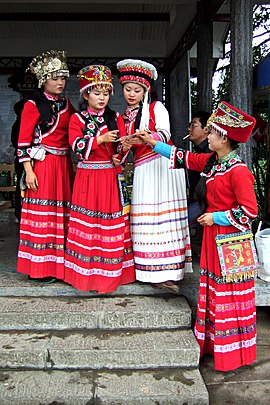http://www.youtube.com/user/cctv9documentary
http://www.youtube.com/watch?v=Ebr1Tk0m7hA
http://www.youtube.com/watch?v=vahGs7QKpFw
http://www.youtube.com/watch?v=7GH54rcLooY
http://www.youtube.com/watch?v=Jj04T1G00rg
http://www.youtube.com/watch?v=1NXN4ySVbro
more:
http://www.youtube.com/results?search_query=tujia+people&oq=tujia+people&aq=f&aqi=&aql=&gs_sm=e&gs_upl=15373l22308l0l23668l9l9l0l4l0l2l160l677l0.5l5l0
The CCTV documentary channel is a window to the rich culture and heritage of China. The first dedicated documentary channel in China with worldwide coverage. The documentary channel features outstanding documentaries covering all aspects of art, culture, music, science, sport, archaeology and more.
历史(History), 考古(Archeology), 语言(Language), 文学(Literature), 写作(Writing), 作诗填词(Writing Poems), 哲学(Philosophy), 读经(Reading Buddhist Manuscript), 射箭(Archery), 电脑(Computer), 看电影(Watch Movie), 听音乐(Listen to Music), 舞蹈(Dancing)
http://en.wikipedia.org/wiki/Tujia_people
 |
The Tujia (Tujia: Bizika; Chinese: 土家族; pinyin: Tǔjiāzú), with a total population of over 8 million, is the 6th largestethnic minority in People's Republic of China. They live in Wuling Mountains, straddling the common borders ofHunan, Hubei and Guizhou Provinces, and Chongqing Municipality.
The endonym Bizika means "native dwellers". In Chinese, Tujia means also "local", as distinguished from theHakka (Chinese: 客家, Kèjiā) whose name implies wandering.[1]
Contents[hide] |
[edit]The Origins of the Tujia
Although there are different accounts of their origins, the Tujia may trace their history back over twelve centuries, and possibly beyond, to the ancient Ba people who occupied the area around modern-day Chongqing some 2,500 years ago. The Ba Kingdom reached the zenith of its power between 600 BC and 400 BC but was destroyed by theQin in 316 BC. After being referred to by a long succession of different names in ancient documents, they appear in historical records as the Tujia from about 14th century onwards.
[edit]The Tujia under the Ming and Qing Dynasties
The Tujia tusi chieftains reached the zenith of their power under the Ming Dynasty (1368–1644), when they were accorded comparatively high status by the imperial court. They achieved this through their reputation as providers of fierce, highly-disciplined fighting men, who were employed by the emperor to suppress revolts by other minorities. On numerous occasions, they also helped defend China against outside invaders, such as the"Japanese" pirates who ravaged the coast during the 16th century.
The Manchus conquered China in 1644 and established the Qing Dynasty. Ever suspicious of local rulers, the Qing emperors always tried to replace Chinese officials with Manchu officials wherever they could. In the early 18th century, the Qing court finally felt secure enough to establish direct control over minority areas as well. This process, known as gaituguiliu (literally 'replace the local [ruler], return to mainstream [central rule]'), was carried out throughout south-west China gradually and, in general, peacefully. The court adopted a carrot-and-stick approach of lavish pensions for compliant chieftains, coupled with a huge show of military force on the borders of their territories.
Most of the Tujia areas returned to central control during the period 1728-1735. Whilst the Tujia peasantry probably preferred the measured rule of Qing officials to the arbitrary despotism of the Tujia chieftains whom they had replaced, many resented the attempts of the Qing court to impose national culture and customs on them. With the weakening of central Qing rule, numerous large-scale uprisings occurred. The Taiping Rebellion affected the area badly, and western imperialist aggression caused great economic hardship as cheap foreign goods flooded the region, with local products being bought up at rock-bottom prices.
[edit]Recent history

Following the collapse of the Qing Dynasty, the Tujia found themselves caught between various competing warlords. More and more land was given over to the cultivation of high-earning opium at the insistence of wealthy landlords, and banditrywas rife. After the founding of the People's Republic of China in 1949, Tujia areas came under Communist control, andbanditry was rapidly eradicated. Subsequent land reform meant that the spectre of starvation ceased to be the ever-present companion of the peasant farmer.[citation needed]
The Tujia were officially recognised as one of the 55 ethnic minorities in January 1957, and a number of autonomous prefectures and counties were subsequently established.
State Councillor Dai Bingguo is the most prominent Tujia in the Chinese government and is one of China's top officials on foreign policy.
[edit]Culture
Today, traditional Tujia customs can only be found in the most remote areas.
The Tujia are renowned for their singing and song composing abilities and for their tradition of the Baishou Dance (摆手舞), a 500 year old collective dance which uses 70 ritual gestures to represent war, farming, hunting, courtship and other aspects of traditional life. They are also famous for their richly-patterned brocade, known asxilankapu, a product that in earlier days regularly figured in their tribute payments to the Chinese court.
Regarding religion, most of the Tujia worship a white tiger totem, although some Tujia in western Hunan worship a turtle totem.
[edit]Language
Tujia is a Tibeto-Burman language and is usually considered an isolate within this group, although it has grammatical and phonological similarities with Yi (though its vocabulary is very different).supsupsupsupsup

No comments:
Post a Comment